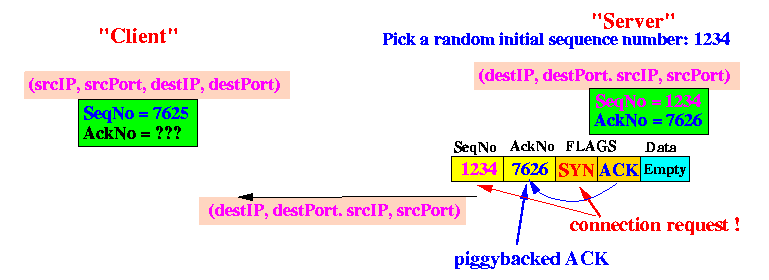- Goal of the
TCP connection establishment
procedure:
- Make sure that:
A's send seq no = B's ACK no and A's ACK no = B's send seq noGraphically:

- Make sure that:
- Also:
- A's send sequence number must be random
- B's send sequence number must be random
- Very important facts:
- A TCP connection (SYN) request
must be
processed
reliably
I.e.:
- A SYN message must be acknowledged
- The SYN message uses
- 1 send sequence number
- A TCP connection (SYN) request
must be
processed
reliably
- The step
to
establish a TCP connection
is as follows:
- The client that
want to establish a
TCP connection:
- Client creates a TCP connection record for the TCP connection
- Client first picks a random (send) sequence number
- Client sends a SYN message with the send seq no
- The ACK bit in the SYN message is reset ( because the message contains an invalid ACK no !!!)
Example:

Meaning:
- requests that the receiver (server) creates a TCP connection with the ACK number = 7625+1
Note:
- The srcIP and srcIP addresses are sent in the IP packet header
- The TCP srcPort# and TCP destPort# are sent in the TCP header
- When the server (receiver)
receives the
SYN 7625
request:
- Server
creates a
TCP connection record for the
TCP connection
- Server sets
ACK no = 7626 (not 7625 !!!)because:
- The SYN request has send seq no = 7625
- The next sequence number = 7626 !!!
Graphically:

(Server must send ACK for SYN request --- see Response action)
Response action:
- Server picks
its own random
(send) seq. no.
- Server sends
back
2 items:
- A SYN request with the (random) send seq no to client and
- Piggyback the ACK 7626 for the client's SYN request
Example response:

Meaning:
- SYN 1234 will
request the
client to:
- requests that the client creates a TCP connection with the ACK number = 1234+1
- ACK 7626 will:
- acknowledge the client's SYN 7625 request
- Server
creates a
TCP connection record for the
TCP connection
- When the client receives
the SYN 1234 request
+
ACK 7626 reply:
- SYN processing ---
the client sets:
ACK no = 1235 (1234 is used for the SYN request)(Client must send ACK for SYN request)
- ACK 7626 processing ---
the client sets:
(client's own) send seq no = 7626
Graphically:

Response action:
- Client
must
acknowledge the
SYN request of the
server:
- Send back: ACK 1235 (for the SYN 1234 request)
Example:

Meaning:
- ACK 1235 will:
- acknowledge the server's SYN 1234 request
- SYN processing ---
the client sets:
- When the server
receives the
ACK (only) message:
- ACK 1235 processing ---
the server sets:
(server's) send seq no = 1235
Note:
- An ACK (only) message must not be acknowledged !!!
Graphically:

No message needs to be send back ....
Protocol ends !!!
Result:
- Client
and server
both
has the correct:
- Send sequence number and
- ACK number
- ACK 1235 processing ---
the server sets:
- The client that
want to establish a
TCP connection:
- Three-way handshake
- The above procedure is called
three-way handshake
(because it uses 3 messages to complete the steps).
- The above procedure is called
three-way handshake